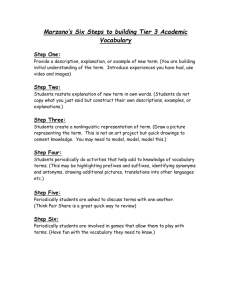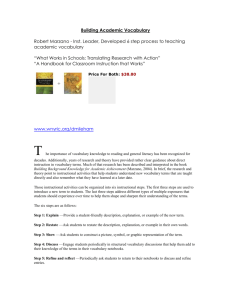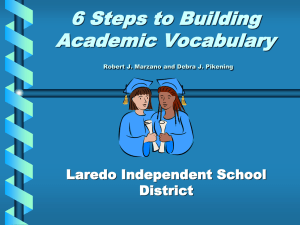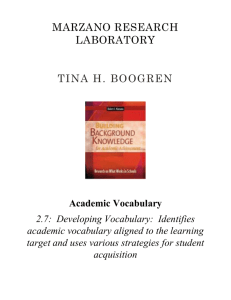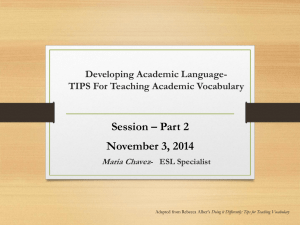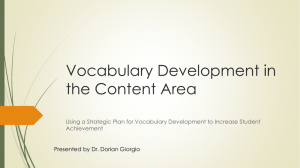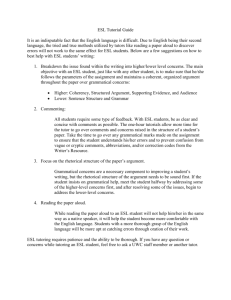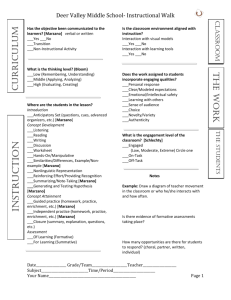Vocabulary Lesson Plan
advertisement
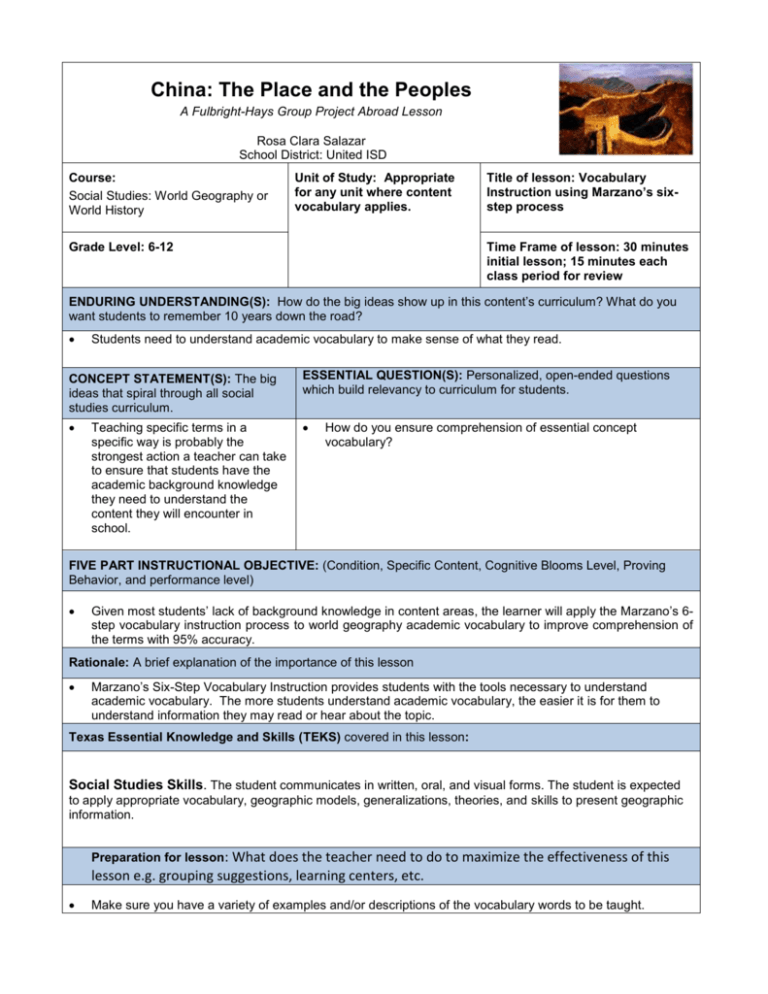
China: The Place and the Peoples A Fulbright-Hays Group Project Abroad Lesson Rosa Clara Salazar School District: United ISD Course: Social Studies: World Geography or World History Unit of Study: Appropriate for any unit where content vocabulary applies. Grade Level: 6-12 Title of lesson: Vocabulary Instruction using Marzano’s sixstep process Time Frame of lesson: 30 minutes initial lesson; 15 minutes each class period for review ENDURING UNDERSTANDING(S): How do the big ideas show up in this content’s curriculum? What do you want students to remember 10 years down the road? Students need to understand academic vocabulary to make sense of what they read. CONCEPT STATEMENT(S): The big ideas that spiral through all social studies curriculum. ESSENTIAL QUESTION(S): Personalized, open-ended questions which build relevancy to curriculum for students. Teaching specific terms in a specific way is probably the strongest action a teacher can take to ensure that students have the academic background knowledge they need to understand the content they will encounter in school. How do you ensure comprehension of essential concept vocabulary? FIVE PART INSTRUCTIONAL OBJECTIVE: (Condition, Specific Content, Cognitive Blooms Level, Proving Behavior, and performance level) Given most students’ lack of background knowledge in content areas, the learner will apply the Marzano’s 6step vocabulary instruction process to world geography academic vocabulary to improve comprehension of the terms with 95% accuracy. Rationale: A brief explanation of the importance of this lesson Marzano’s Six-Step Vocabulary Instruction provides students with the tools necessary to understand academic vocabulary. The more students understand academic vocabulary, the easier it is for them to understand information they may read or hear about the topic. Texas Essential Knowledge and Skills (TEKS) covered in this lesson: Social Studies Skills. The student communicates in written, oral, and visual forms. The student is expected to apply appropriate vocabulary, geographic models, generalizations, theories, and skills to present geographic information. Preparation for lesson: What does the teacher need to do to maximize the effectiveness of this lesson e.g. grouping suggestions, learning centers, etc. Make sure you have a variety of examples and/or descriptions of the vocabulary words to be taught. VISUALS, MATERIALS, AND TEXTS: RESOURCES & TECHNOLOGY A variety of pictures, examples, and /or descriptions of the selected vocabulary terms Prior Knowledge: What do students need to know before this lesson e.g. content or skills? PROCEDURES/ACTIVITIES CHECK FOR UNDERSTANDING This should be done continuously during the lesson LESSON COMPONENTS FORCUS/SET OR HOOK: Attention getter? Write the selected vocabulary terms on the board. Ask students what they already know or think they know about the selected vocabulary terms. INPUT: Explanation – clear steps to teaching this lesson Divide students into cooperative groups of 4-5 students. Give each student copies of the student vocabulary notebook page or have them create one of their own following the template. The first three steps, used as a set, ensure that terms are properly introduced and help students develop an initial understanding of them. The last three steps describe different types of multiple exposures that students should experience over time to help them gain a deeper understanding of the terms. Step 1: Provide a description, explanation, or example of the new term Examples: Tell a story that integrates the term. Use images as the stimulus for understanding Describe your own mental picture Ask individual students Step 2: Ask students to restate the description, explanation, or example in their own words. Allow students to discuss the term with a partner or in their small group Using a cluster map, write ideas the students offer for each of the vocabulary terms. Have students write the vocabulary word in the section labeled Term and determine their understanding of it by circling the numbers next to Understanding (1 being the lowest level of understanding) Have students restate in their own words in the section labeled Describe When you ask students to restate in their own words what has been presented in the introduction to the term it is critical that they do not simply copy what you have said, but that they construct their own descriptions. Monitor students’ work and help them clear up any confusion or major errors as they work. Provide opportunities for the student to add to, or revise their entries. Step 3: Ask students to construct a picture, symbol, or graphic representation of the term Step 4: Engage students periodically in activities that help them add to their knowledge of the terms in their vocabulary pages. Highlight a prefix or suffix that will help them Students may use the extra space in the vocabulary notebook page to record any new information. Step 5: Periodically ask students to discuss the terms with one another. Use Think-Pair-Share Monitor student discussions of their descriptions and pictures. Encourage students to clear up misconceptions and confusion. Step 6: Involve students periodically in games that allow them to play with the terms. Pictionary Jeopardy Name That Term MODEL: Does the teacher need to do a Think Aloud or demonstrate a skill; show models of products? For Step 3: Provide examples of students’ drawings and your own drawings For Step 5: (think-pair-share activity) model think aloud some of the things students may consider during the “think” time GUIDED PRACTICE: What will students do alone but under the teacher’s supervision? If students are not accustomed to creating pictures for ideas, initially, they might need significant guidance and modeling. CLOSURE: method of summarizing/reviewing the lesson Set aside time each week to play games or use them spontaneously to energize students. Have students draw their picture in the section labeled Draw Allow students to discuss or work together remember the meaning of the term Draw an additional picture List related words Translate the term into another language, if English is the student’s second language Invite students to share aloud with the whole class any new thoughts or understandings they have discussed with their teammates. Have students complete the first 3 steps for the remaining vocabulary terms. ASSESSMENT(S): How will students demonstrate mastery? Include assessment tools, rubric, rating scale, test Students take weekly vocabulary quizzes to determine level of understanding. ACCOMMODATIONS/ENRICHMENTS Accommodations: ESL: Pair students with English-speaking students. Provide students with forms of nonlinguistic representations (pictures) as ESL might not benefit very much from verbal explanations. Allow students to write the description in their native language, unless they are comfortable using English. Encourage ESL students to record any English terms they are familiar with that are related to the term being presented. Encourage students to make connections to their native culture. Enrichment: SILENT/SUSTAINED READING RESOURCES
